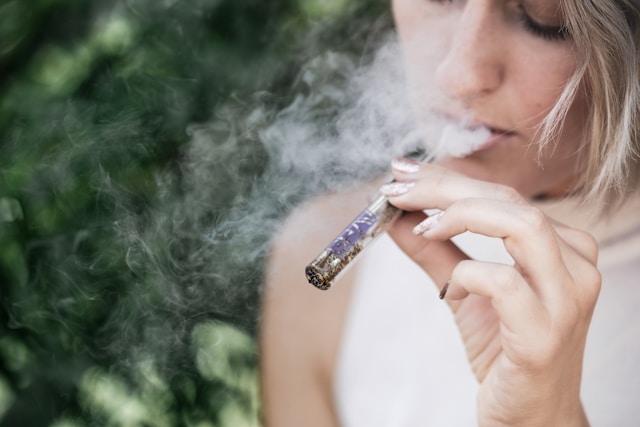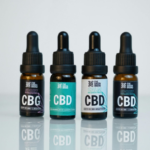Knowing why cannabis can make you feel sleepy is an excellent way to counteract and manage this effect. You might enjoy the relaxation, or perhaps you want to maintain more consistent energy levels.
Here, we delve into the reasons behind cannabis-induced drowsiness and explore what can be done to address it.
Why Does Weed Make You Tired?
Cannabis can make you feel tired due to its interaction with your body’s endocannabinoid system. The compounds in cannabis, particularly THC (tetrahydrocannabinol), bind to cannabinoid receptors in your brain and body, affecting various physiological processes.
One reason for the drowsiness is that THC can bind to receptors in the hypothalamus, a region of the brain involved in regulating sleep. This interaction can disrupt the normal sleep-wake cycle, leading to feelings of drowsiness or fatigue.
Moreover, cannabis can also lower blood pressure and relax muscles, which can contribute to feelings of tiredness. Additionally, certain strains of cannabis contain compounds called terpenes, which may have sedative effects and contribute to the feeling of being sleepy.
What Strain of Weed Makes You More Tired?
Strains of cannabis that are most likely to make you feel tired and induce sleepiness are typically Indica-dominant strains.
These strains have specific cannabinoid and terpene profiles that contribute to their sedative effects.
Here are some common Indica strains known for their ability to promote relaxation and sleepiness:
Granddaddy Purple (GDP)
- Cannabinoid Profile: High THC content.
- Terpene Profile: Myrcene (sedative), pinene (calming), and caryophyllene (stress relief).
- Effects: Deep relaxation, pain relief, and significant sedation.
Northern Lights
- Cannabinoid Profile: High THC content.
- Terpene Profile: Myrcene, pinene, and caryophyllene.
- Effects: Euphoria, relaxation, and strong sedative properties.
Bubba Kush
- Cannabinoid Profile: High THC, moderate CBD.
- Terpene Profile: Myrcene, limonene, and caryophyllene.
- Effects: Full-body relaxation, stress relief, and drowsiness.
Afghan Kush
- Cannabinoid Profile: High THC.
- Terpene Profile:Myrcene, caryophyllene, and humulene.
- Effects:Heavy sedation, relaxation, and sleep induction.
Blueberry
- Cannabinoid Profile: High THC.
- Terpene Profile: Myrcene, pinene, and caryophyllene.
- Effects:Relaxation, euphoria, and strong sedative effects.
Purple Kush
- Cannabinoid Profile: High THC.
- Terpene Profile: Myrcene, caryophyllene, and humulene.
- Effects: Long-lasting euphoria, pain relief, and deep sedation.
LA Confidential
- Cannabinoid Profile: High THC.
- Terpene Profile: Myrcene, caryophyllene, and limonene.
- Effects: Relaxation, stress relief, and significant drowsiness.
Why These Weed Strains Make You Tired
- High Myrcene Levels: Myrcene is a terpene commonly found in Indica strains and is known for its sedative and muscle-relaxing properties.
- High THC Content: THC can induce relaxation and sedation, particularly in higher doses.
- Balanced Cannabinoid Profiles: Some strains have higher CBD content, which can further promote relaxation and counteract the stimulating effects of THC.
- Synergistic Terpene Effects: The combination of terpenes like myrcene, linalool, humulene, and others contributes to the overall calming and sedative effects.
Getting Your Cannabis Correct to Avoid Fatigue
Cannabis can have varying effects depending on the strain, dosage, and individual tolerance. Here’s how to manage your dose to avoid fatigue and enhance energy levels:
Understanding Strains
When selecting a strain, it’s essential to understand its indica or sativa dominance and consider your desired effects:
- Sativa: Known for its energizing effects, often recommended for daytime use.
- Indica: Typically induces relaxation and can cause drowsiness, better for evening use.
- Hybrid: Contains characteristics of both Sativa and Indica; effects depend on the dominant strain.
Start Low and Go Slow
Microdosing, by beginning with a very small dose (e.g., 1-2.5 mg of THC).Gradually increase the dose to find the minimal effective dose that achieves the desired effect without causing fatigue.
Method of Consumption
Method of consumption can also influence the likelihood of experiencing tiredness after using weed.
- Inhalation (smoking/vaping): Effects are felt quickly, allowing for easier dose control.
- Edibles: Effects take longer to set in and last longer; start with a very low dose (e.g., 2.5 mg THC).
- Tinctures and Sublinguals: Fast onset similar to inhalation, but easier to dose precisely.
Time of Day
Indica strains are often preferred for nighttime or evening use when individuals are looking to wind down and prepare for sleep. These strains can help promote a restful night’s sleep due to their calming and sedative properties.
Conversely, sativa strains are generally more energizing and uplifting and are often chosen for daytime use when individuals want to remain alert and active.
Monitor and Adjust
Keep a journal to track your doses, strains, times of use, and effects. Adjust doses based on your energy levels and how you feel throughout the day.
Does Indica Make You Lazy?
Indica strains of cannabis are often associated with sedative effects and a sense of relaxation, which can sometimes lead to feelings of lethargy or “couch-lock.” This association has led to the colloquial term “indica” being used interchangeably with “in-da-couch.”
While indica weed strains are often prized for their ability to induce relaxation and promote sleep, they don’t inherently make someone lazy.
The perception of laziness or lethargy associated with indica strains is more likely a result of the calming and sedative effects they produce, which can lead to a desire to unwind and relax, rather than engage in physically or mentally demanding activities.
Can Weed Make You Tired the Next Day?
While cannabis can sometimes cause feelings of tiredness or grogginess while you’re under its immediate influence, it’s less common for it to directly cause tiredness the next day.
However, there are a few indirect ways that cannabis use might affect your energy levels the day after consumption:
- Residual Effects: Depending on the potency of the cannabis you consumed and your individual metabolism, you might still feel residual effects the next day, such as grogginess or mild fatigue, especially if you consumed a large amount or a particularly potent strain.
- Disrupted Sleep: Cannabis can affect the quality and patterns of your sleep, particularly if consumed shortly before bedtime.
While it can help some people fall asleep faster, it may also disrupt REM (rapid eye movement) sleep, which is crucial for feeling refreshed the next day. Poor-quality sleep can leave you feeling tired or less alert the following day.
- Dehydration: Some methods of consuming cannabis, such as smoking or vaping, can lead to dehydration, which can contribute to feelings of tiredness the next day.
Make sure to stay hydrated by drinking plenty of water, especially if you consume cannabis through methods that can dehydrate you.
- Individual Differences: People react differently to cannabis, so while some individuals may not experience any lingering tiredness the next day, others might feel more fatigued or “foggy.”
Factors such as tolerance, metabolism, and overall health can influence how your body processes and responds to cannabis.
Do Terpenes Cause Fatigue?
Terpenes are aromatic compounds found in many plants, including cannabis, and they contribute to the plant’s flavor and aroma profile.
While terpenes are not typically known to directly cause fatigue, certain terpenes may have relaxing or sedative effects that could contribute to feelings of tiredness, especially when consumed in high concentrations or in combination with other compounds in cannabis.
For example, the terpene myrcene, which is commonly found in cannabis, has been associated with sedative effects and is believed to contribute to the “couch-lock” sensation often attributed to certain indica strains.
Similarly, linalool, another terpene found in cannabis as well as lavender, has calming and relaxing properties.
Does Sativa Also Make You Sleepy?
While sativa strains are generally associated with more energizing and uplifting effects compared to indica strains, they can still induce feelings of relaxation and, in some cases, sleepiness, especially at higher doses or in sensitive individuals.
Sativa strains typically contain higher levels of THC relative to CBD, which can contribute to their stimulating effects.
Does CBG Make You Sleepy?
CBG, or cannabigerol, is a cannabinoid found in cannabis that has been gaining attention for its potential therapeutic effects.
While research on CBG is still in its early stages, there is limited evidence to suggest that CBG may have sedative properties and could potentially contribute to feelings of sleepiness.
Some studies have indicated that CBG may interact with receptors in the brain and nervous system that are involved in regulating sleep and relaxation.
Additionally, CBG may also influence the activity of neurotransmitters such as GABA, which has calming effects and is involved in sleep regulation.
Final Thoughts
When seeking a cannabis strain that promotes relaxation Indica-dominant strains are your best bet.
Strains such as Granddaddy Purple, Northern Lights, Bubba Kush, Afghan Kush, Blueberry, Purple Kush, and LA Confidential are renowned for their high myrcene content and sedative effects, making them ideal for nighttime use.
As with any substance, moderation and mindful consumption are key. If you’re using cannabis for its potential sleep-inducing effects, it’s essential to find the right balance to avoid excessive drowsiness or grogginess the next day.
Additionally, consulting with a healthcare professional can provide personalized guidance and support for managing sleep issues.


